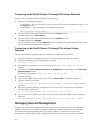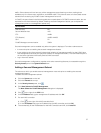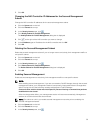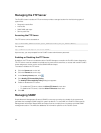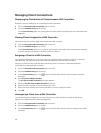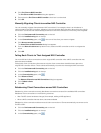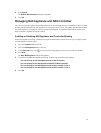
Managing the FTP Server
The FluidFS cluster includes an FTP server that provides a storage location for the following types of
system files:
• Diagnostic results files
• License file
• SNMP MIBs and traps
• Service pack files
Accessing the FTP Server
The FTP server can be accessed at:
ftp://<FluidFS_administrator_user_name>@<client_VIP_or_name>:44421/
For example:
ftp://Administrator@172.22.69.32:44421/
Upon access, you are prompted for the FluidFS cluster administrator password.
Enabling or Disabling the FTP Server
By default, the FTP server is enabled to allow FluidFS Manager to transfer the FluidFS cluster diagnostics.
The FTP server must be enabled to upload service packs and license files, to access and transfer FluidFS
cluster diagnostic results, and to access SNMP MIBs and traps.
To enable or disable the FTP server:
1. Click the System tab on the left.
2. Click the Internal tab on the top.
3. In the Security Access pane, click .
4. Click Modify FTP Accessibility Policy.
The Modify FTP Accessibility Policy dialog box appears.
5. Enable or disable the FTP server.
– To enable the FTP server, select the Allow FTP Access`check box.
– To disable the FTP server, clear the Allow FTP Access check box.
6. Click OK.
Managing SNMP
Simple Network Management Protocol (SNMP) is one way to monitor the health of the system and
generate alert messages (SNMP traps) for system problems. To use SNMP, the FluidFS cluster‐specific
Management Information Bases (MIBs) and traps must be compiled into a customer‐provided SNMP
management station. The MIBs are databases of information specific to the FluidFS cluster.
44



